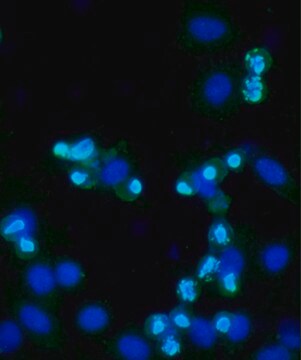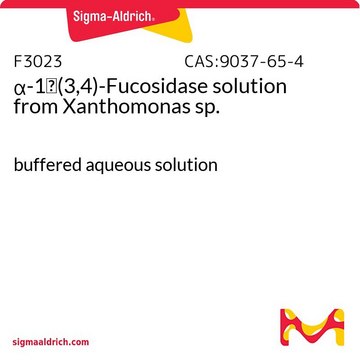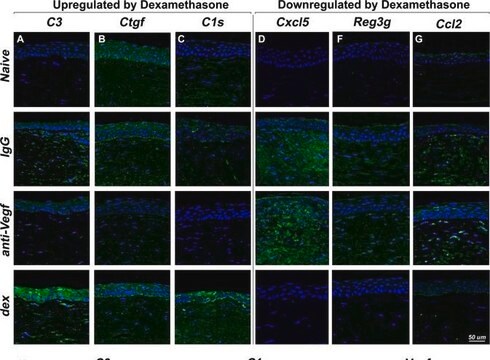H9908
Monoclonal Anti-phospho-Histone H3 (pSer28) antibody produced in rat
~0.5 mg/mL, clone HTA28, purified immunoglobulin, buffered aqueous solution
Sinónimos:
Monoclonal Anti-H3S28p
About This Item
Productos recomendados
origen biológico
rat
Nivel de calidad
conjugado
unconjugated
forma del anticuerpo
purified immunoglobulin
tipo de anticuerpo
primary antibodies
clon
HTA28, monoclonal
Formulario
buffered aqueous solution
mol peso
antigen 15 kDa
reactividad de especies
bovine, mouse, hamster, human
envase
antibody small pack of 25 μL
concentración
~0.5 mg/mL
técnicas
flow cytometry: suitable
immunocytochemistry: suitable using 3.7% formaldehyde-methanol fixation
microarray: suitable
western blot: 0.5-1 μg/mL using whole extract of cultured human acute T cell leukemia Jurkat cells treated with Nocodazole.
isotipo
IgG2a
Nº de acceso UniProt
Condiciones de envío
dry ice
temp. de almacenamiento
−20°C
modificación del objetivo postraduccional
phosphorylation (pSer28)
Información sobre el gen
human ... H3F3A(3020) , H3F3B(3021) , HIST1H3A(8350) , HIST1H3B(8358) , HIST1H3C(8352) , HIST1H3D(8351) , HIST1H3E(8353) , HIST1H3F(8968) , HIST1H3G(8355) , HIST1H3H(8357) , HIST1H3I(8354) , HIST1H3J(8356) , HIST2H3A(333932) , HIST2H3C(126961) , HIST3H3(8290)
mouse ... H3f3a(15078) , H3f3b(15081) , Hist1h3a(360198) , Hist1h3b(319150) , Hist1h3c(319148) , Hist1h3d(319149) , Hist1h3e(319151) , Hist1h3f(260423) , Hist1h3g(97908) , Hist1h3h(319152) , Hist1h3i(319153) , Hist2h3b(319154) , Hist2h3c1(15077) , Hist2h3c2(97114)
Descripción general
Especificidad
Inmunógeno
Aplicación
Acciones bioquímicas o fisiológicas
H3 phosphorylation may contribute to proto-oncogene induction by modulating chromatin structure and releasing blocks in elongation. H3 dephosphorylation occurs quite rapidly after mitosis and serine-10/28 reo main unphosphorylated throughout the remainder of interphase. PP1 has been identified as the H3 phosphatase.
Forma física
Nota de preparación
Almacenamiento y estabilidad
Cláusula de descargo de responsabilidad
¿No encuentra el producto adecuado?
Pruebe nuestro Herramienta de selección de productos.
Código de clase de almacenamiento
10 - Combustible liquids
Clase de riesgo para el agua (WGK)
WGK 3
Punto de inflamabilidad (°F)
Not applicable
Punto de inflamabilidad (°C)
Not applicable
Elija entre una de las versiones más recientes:
Certificados de análisis (COA)
¿No ve la versión correcta?
Si necesita una versión concreta, puede buscar un certificado específico por el número de lote.
¿Ya tiene este producto?
Encuentre la documentación para los productos que ha comprado recientemente en la Biblioteca de documentos.
Nuestro equipo de científicos tiene experiencia en todas las áreas de investigación: Ciencias de la vida, Ciencia de los materiales, Síntesis química, Cromatografía, Analítica y muchas otras.
Póngase en contacto con el Servicio técnico








